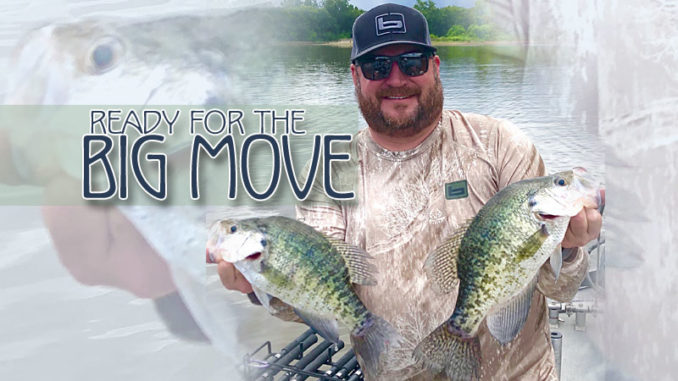
As fall progresses, crappie head from their shallower, fall spots toward the deeper water where they’ll spend the winter. Here’s how a Louisiana crappie pro follows them.
Most Louisiana crappie fishermen start walking around with a sly grin on their face as fall approaches. They know lakes are going to be a little less crowded because hunting seasons will be open.
There’s at least one exception to that rule. Ken Myers of Choudrant is a pro crappie fisherman, but he’s also a duck hunter. In fact, his crappie boat is wrapped by one of his sponsors, Banded Outdoor Apparel, so it’s hard to know whether that smirk on his face is related to crappie or mallards.
“It is tough on me,” Myers said. “I love them both, so I try and manage a good crappie/duck life balance. I know when I’m hunting, I’m missing some of the best crappie fishing of the year. And yes, I enjoy fishing when there aren’t so many people on the lake, too.”
Lots of options
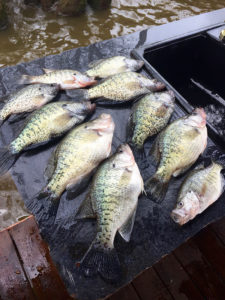
Louisiana’s crappie waters are diverse. You’ve got Lake Verret and the Atchafalaya Basin with great fall crappie, and Larto Lake in central Louisiana is a prime fall crappie stop. In fact, Larto fishermen fish the same waters this time of year that many waterfowlers hunt; fishermen often wait and go later in the day when the duck hunters are done. The fish are still there.
Then, there’s huge Toledo Bend, known for great fishing when the crappie start moving on up into the creek channels and deeper brush tops to feed for the winter. And then you’ve got reservoirs like Lake D’Arbonne and Bistineau, both prime crappie lakes.
“All these lakes fish differently to some extent, but sometimes we make it more complicated than we should,” Myers said. “Look, here’s the honest truth. A crappie is a crappie whether it is in Lake Verret or D’Arbonne or the Ouachita River.
“There’s one thing that they all have in common. They are going to follow the baitfish. It’s really that simple. You find the baitfish, you find the crappie. And in the fall, they are super aggressive.”
Scouting for fish
With today’s electronics, many fishermen, Myers included, spend as much time scouting in the fall as they do fishing. If you don’t have good electronics, just see what others are doing and mimic the ones catching fish. Fish the same way and the same types of areas they are fishing.
“We literally do spend just about as much time scouting, finding brush and drop-offs that hold fish, and we look for those big balls of baitfish,” he said. “Once you locate what they are doing, then you go fishing. If you only have a day on the weekend to fish, I’d advise you to scout the internet or Facebook and try to pick up some good information to lessen your scouting time. Find the fish. Catch the fish.”
Unless there is some unusual act of nature taking place, you can usually catch crappie when you find them. Sometimes, they are stubborn when the barometric pressure is rising or a big change in temperature — hot or cold — hits, as it often does in the Bayou State this time of year. But most of the time, when you drop the right bait in front of them, some of them will hit it. Where there’s one crappie, there’s usually a bunch.
Bait
Myers has a good suggestion for that “right bait.”
“Shad have had all year to grow, so by this time of year, they are big,” he said. “You want to match the natural food as best you can with your bait. My fishing partner and neighbor, Mark Taylor, and I fish a shiner on a plain hook. Sometimes, we fish a jighead with a plastic trailer, but this time of year, we start bigger than that. Don’t be shy about putting on a 1/4-ounce jighead with a plastic trailer and add a shiner to tip the hook of that. It’s big, but that’s what the crappie like in the fall.”
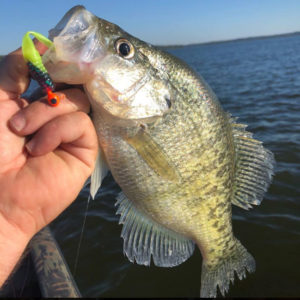
Myers said two trains of thought exist on finding fall crappie. One is to follow a migration pattern that’s the reverse of what they do in spring. In other words, in spring, they go from deep water to staging areas to shallow water to spawn. In the fall, they may be in shallow water, especially when it has the most oxygen, then they move to holding areas before hitting the deepest water they can find in the winter. The fish don’t just move to be moving though; they are following the bait.
“I think the biggest mistake people make is that, while those patterns do hold up, there are lots of other ways to catch crappie,” he said. “They are literally everywhere in most lakes. Don’t lock into one pattern or one area if you aren’t catching fish. Be confident enough to change and try something different, even if it isn’t what you read about in fishing articles.”
How to fish at different places
Myers works as the manager of U.S. Aqua Services in Morgan City, near Lake Palourde, so he’s very familiar with how to catch fish there in fall. There aren’t a lot of deep areas, so fish don’t travel that far, but they still like deeper areas. Fish are usually out from the trees a little farther than normal, on structure. You can try points on Palourde, Lake Verret, Little Bayou Long, Grand Bayou, Bayou Louis, Little Texas Bayou, the Ike Canal and Bayou Magazille.
“The reality is that if the lake is not deep, you can use techniques such as spider-rigging and using multiple baits at different depths to target all of the areas of a shallow lake like Verret,” Myers said. “Remember to look for visible cover like logs and laydowns.”
Myers’ home lake is D’Arbonne; he said the deeper water around the lake’s channels draws the bait. He usually fishes the edge of creeks and sloughs feeding the main-river channel this time of year. However, fish are still on the flats and off the trees in some areas, he said. Popular areas on D’Arbonne are around the Farmersville and Bernice bridges, the Piney Point flats and the Stowe Creek area.
One different body of water is the Ouachita River, which runs all the way from the Arkansas line to below Columbia. Myers said the river lakes are great in the fall, reachable from numerous areas from the Alabama Landing to Sterlington, Monroe and Columbia. If there isn’t a lot of current, fish the brush tops and laydowns in the river itself. There are crappie on almost every one of them.
Cover
One thing all crappie like is cover, Myers said. They suspend sometimes, but they are still probably suspended over cover or a depth break. The baitfish like those areas, too.
“Here’s the deal. We learn a lot of things as crappie fishermen, and they usually work,” he said. “But sometimes, they may not. The rules don’t always apply, especially at this time. Be flexible. Be willing to learn as many techniques and baits as you can, experiment and don’t be slow to change baits or areas if what you are doing isn’t working.”
What are friends for?
Pro crappie fisherman Ken Myers grew up fishing with his father, “Big Ed” — fishing all over. He got hooked on saltwater fishing, especially fishing marlin tournaments in the Gulf of Mexico.
As his family expanded to include three little girls, he decided it was time to stay a little closer to home for fishing, but the competitive spirit still burned. Crappie tournaments were just starting in north Louisiana, and he asked a couple of friends to take him crappie fishing. They did, but they were slow to share all the details with him. Part of paying his dues was fishing in the back of the boat in 8 feet of water, while the fisherman in front was in 18, fishing over the underwater drop-off of a creek.
Hey, what are friends for?
“Those guys, they were the biggest liars,” he said. “They’d show me some stuff, but they left me hanging a lot to learn on my own. I had to weed through trial-and-error by myself. But I was watching and paying attention. I have to credit them with helping me get hooked on the sport.”
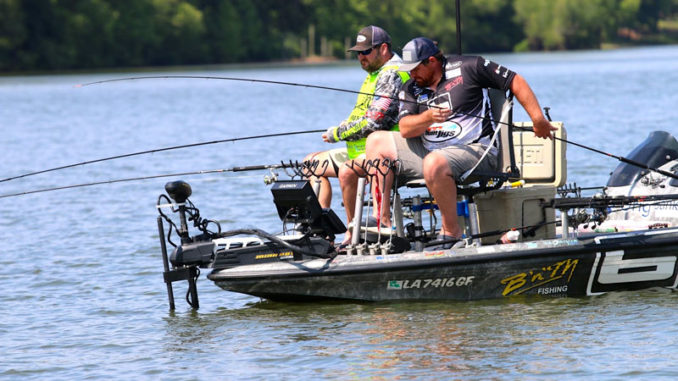
Once, he was supposed to fish in a crappie club tournament with one of those friends, Mark Taylor, who is now his tournament partner. Taylor had to cancel at the last minute and take a family member, so Myers loaded up his crappie gear, rigged his duck boat for spider-rigging and fished the tournament by himself, using what he had learned. Taylor won the tournament, but Myers finished fourth.
“That’s when I knew I could do this,” said Myers, who became a born-again crappie fisherman. “I knew this was the sport for me. I love fishing for them. I love competing for fun and to earn money. And I love to eat crappie. That’s another benefit. Nothing tastes better.”
Bitten by the pro crappie bug
Ken Myers was bitten by the crappie tournament bug about four years ago, not long after he learned how to crappie fish. He partners with Mark Taylor to fish tournaments on the American Crappie Trail and Crappie Masters circuits.
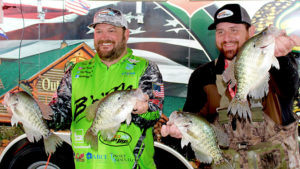
Their goal is to win or at least place in every tournament they fish. Their ultimate goal is to make it to the tours’ national championships, not only for the cash and prizes, but the prestige.
The diversity of lakes on these two tours has made Myers and Taylor learn new techniques and presentations, but not get sucked into doing what somebody else is doing and leave their game plan.
“With the advent of some of the new, forward-looking sonar technology, techniques and presentations have been changing,” he said. “We have to change, too, but still stick to the basics we know about crappie. We are spider-riggers. The more rods, the better for us most of the time, but we still appreciate feeling the thump with one pole in our hand.
There’s a lot that everyday crappie fishermen can learn from watching, reading and following tournament anglers, Myers said, a multitude of information that you can absorb without even hitting the lake. Fishermen should use that to their advantage. And pro circuits are also leading to new innovations, better equipment and better baits and rigs every year.


